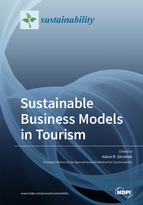Sustainable Business Models in Tourism
A special issue of Sustainability (ISSN 2071-1050).
Deadline for manuscript submissions: closed (31 December 2020) | Viewed by 70550
Special Issue Editor
Interests: tourism; health resorts; business models; spa tourism; management; sustainability
Special Issues, Collections and Topics in MDPI journals
Special Issue Information
Dear Colleagues,
I invite you to participate in a Special Issue on business models in tourism, in the context of considering the principles of sustainable development. The progressing transformation of tourist and healing activities in the scope of the broadly understood organizational and market processes reveals, at the same time, that the tools for operating this activity are outdated. The functioning of an enterprise deprived of reliable strategic tools in a turbulent environment is becoming more and more difficult, and the lack of response to the reported market needs may even lead to a crisis.
Sustainable development, in its broader perspective, is another aspect necessary to include in contemporary business models. A tourist and spa company cannot ignore its own environmental impact or fail to see the consequences of its activities.
It is necessary to offer managers modern management tools that cover the broadest possible scope of integration of the elements of the conducted business activities, at the same time adjusted to the specificity of the market and needs of the natural environment in which the enterprises managed by them operate.
The proposed Special Issues in this journal, formulated in the light of the presented needs, aims to use the concept of business models and sustainability business models in the context of a tourism enterprise adapted to the existing conditions of tourist and spa activities. It is also worth presenting exemplifications of business models and other management methods used in tourism activities.
The thematic scope of the issues addressed in this Special Issue of the journal includes the following:
- management methods dedicated to tourism enterprises and to the sustainable development of tourism destinations
- business models and sustainable business models
- sustainable tourism and sustainable management in tourism
- tourist activity and its consequences (functions and dysfunctions)
- impact of the tourist enterprise on the development of destinations
- implementation of sustainability criteria for tourism
- tourism (especially, spa tourism, cultural heritage tourism, urban tourism, and rural tourism).
References:
- Nosratabadi S., Mosavi A., Shamshirband S., Zavadskas E.K., Rakotonirainy A., Wing Chau K. (2019). Sustainable Business Models: A Review. Sustainability, 11, 1663.
- Wybrańczyk K., Szromek A. (2019) Proposal of Value for Customer of Spas: Expectations of Spa Patients and Tourist in Polish Spas, Sustainability, 11(13), 3598;
- Abdelkafi, N., Täuscher, K. (2016). Business models for sustainability from a system dynamics perspective. Environ, 29, 74–96.
- Naramski, M. Szromek, A.R.; (2019). A Business Model in Spa Tourism Enterprises: Case Study from Poland. Sustainable Tourism—Ways to Counteract the Negative Effects of Overtourism at Tourist Attractions and Destinations. Sustainability, 11, 2880.
- Boons, F.; Lüdeke-Freund, F. (2013). Business models for sustainable innovation: State-of-the-art and steps towards a research agenda. Clean. Prod. 45, 9–19.
- Cape Town Declaration on Responsible Tourism (2018) The Cape Town Conference on Responsible Tourism in Destinations. Responsible Tourism Partnership and Western Cape Tourism. Cape Town 2018. https://responsibletourismpartnership.org/ cape-town-declaration-on-responsible-tourism/ (Access: August 1, 2019)
- Liu, (2003)Sustainable Tourism Development: A Critique,Journal of Sustainable Tourism,11:6,459-475.
- Prendeville S., Bocken N. (2017). Sustainable Business Models through Service Design, Procedia Manufacturing, 8, 292-299.
- Herman, K., Szromek, A. R.; (2019). A Business Creation in Post-Industrial Tourism Objects: Case of the Industrial Monuments Route. Sustainability, 11, 5, 1451.
- Zhenhua L., Sustainable Tourism Development: A Critique. Journal of Sustainable Tourism 11(6), 2003, 459-475.
Prof. Dr. Adam R. Szromek
Guest Editor
Manuscript Submission Information
Manuscripts should be submitted online at www.mdpi.com by registering and logging in to this website. Once you are registered, click here to go to the submission form. Manuscripts can be submitted until the deadline. All submissions that pass pre-check are peer-reviewed. Accepted papers will be published continuously in the journal (as soon as accepted) and will be listed together on the special issue website. Research articles, review articles as well as short communications are invited. For planned papers, a title and short abstract (about 100 words) can be sent to the Editorial Office for announcement on this website.
Submitted manuscripts should not have been published previously, nor be under consideration for publication elsewhere (except conference proceedings papers). All manuscripts are thoroughly refereed through a single-blind peer-review process. A guide for authors and other relevant information for submission of manuscripts is available on the Instructions for Authors page. Sustainability is an international peer-reviewed open access semimonthly journal published by MDPI.
Please visit the Instructions for Authors page before submitting a manuscript. The Article Processing Charge (APC) for publication in this open access journal is 2400 CHF (Swiss Francs). Submitted papers should be well formatted and use good English. Authors may use MDPI's English editing service prior to publication or during author revisions.
Keywords
- tourism
- business models
- management
- sustainable development






